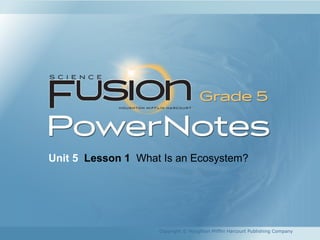More Related Content
Similar to Ecosystem (20)
More from Gladimar Marín (20)
Ecosystem
- 1. Unit 5 Lesson 1 What Is an Ecosystem?
Copyright © Houghton Mifflin Harcourt Publishing Company
- 2. Unit 5 Lesson 1 What Is an Ecosystem?
What Is an Ecosystem?
Copyright © Houghton Mifflin Harcourt Publishing Company
• An organism’s environment is all the living and
nonliving things that surround and affect the
organism.
• Environments include biotic and abiotic parts.
Biotic parts are living things in an environment,
such as plants, animals, and other organisms.
• Abiotic parts are nonliving things in an
environment, such as climate, water, soil, light,
air, and nutrients.
- 3. Unit 5 Lesson 1 What Is an Ecosystem?
What Is an Ecosystem?
Copyright © Houghton Mifflin Harcourt Publishing Company
• Abiotic parts of an environment have an important
role. Temperature and amount of water affect
which plants and animals can live in a place.
• An ecosystem is all the organisms living in a
place together with their environment. Each
ecosystem has its own living and nonliving things.
• An ecosystem can be huge, such as a large forest
or desert, or it can be small, such as a mud
puddle or a single bush.
- 4. Copyright © Houghton Mifflin Harcourt Publishing Company
• A group of organisms of the same species in an
ecosystem is called a population.
• Each ecosystem contains different groups of living
things. A savanna ecosystem may contain
populations of zebras as well as grasses and trees.
Unit 5 Lesson 1 What Is an Ecosystem?
Populations and Communities
- 5. Copyright © Houghton Mifflin Harcourt Publishing Company
• The different populations that share an ecosystem
make up a community.
• A community consists of all the populations that
live and interact in an area.
Unit 5 Lesson 1 What Is an Ecosystem?
Populations and Communities
- 6. Copyright © Houghton Mifflin Harcourt Publishing Company
• Populations in every ecosystem need food, water,
shelter, and space to live.
• The interaction between populations to meet these
needs is called competition.
Unit 5 Lesson 1 What Is an Ecosystem?
Populations and Communities
- 7. Copyright © Houghton Mifflin Harcourt Publishing Company
• Populations that compete and obtain enough
resources will survive, while those that cannot
compete will not survive.
• These resources are called limiting factors,
because there is only enough food, water, shelter,
and space to support a certain number of
organisms.
• Competition also occurs within populations.
Stronger individuals get the most food and best
shelter. Thus, weaker individuals may not survive.
Unit 5 Lesson 1 What Is an Ecosystem?
Populations and Communities
- 8. Copyright © Houghton Mifflin Harcourt Publishing Company
• An organism’s habitat is the place where it lives
within an ecosystem. Several populations share
the same habitat.
• An organism’s niche is its complete role or
function in its ecosystem. A niche includes all the
ways the organism survives.
• An organism’s niche includes how it finds food, as
well as the climate in which it thrives.
Unit 5 Lesson 1 What Is an Ecosystem?
Find Your Niche
- 9. Copyright © Houghton Mifflin Harcourt Publishing Company
• Every organism has a niche. Having different
niches allows different organisms to survive in the
same habitat.
• Organisms with a specific way of living have a
narrow niche. For example, an animal that eats
only one type of food cannot survive without that
food.
• Organisms with narrow niches tend to live in
specific places, while those with broad niches
often move around large areas.
Unit 5 Lesson 1 What Is an Ecosystem?
Find Your Niche
- 10. Copyright © Houghton Mifflin Harcourt Publishing Company
• Populations can share a habitat but not the same
niche.
• For example, red-shouldered hawks and barred owls
share a habitat, but have different niches. They both
hunt different prey at different times of the day.
• If two populations of organisms share a niche, they
must compete for resources.
Unit 5 Lesson 1 What Is an Ecosystem?
Find Your Niche
- 11. Copyright © Houghton Mifflin Harcourt Publishing Company
• Diverse means different in kind. Diversity is the
variety of different species that live in an ecosystem.
• An ecosystem that is very diverse contains many
species. Ecosystems without much diversity may be
inhabited by only a few species.
• Organisms are connected in a large, complex web.
The more types of organisms in an ecosystem, the
larger the web, and the more resources available.
Unit 5 Lesson 1 What Is an Ecosystem?
Diversity
- 12. • Climate and location affect the amount and types
of resources that are available for organisms.
• Generally, very diverse ecosystems, such as coral
reefs and rain forests, are near the equator. Less
diverse ecosystems are farther from the equator.
Copyright © Houghton Mifflin Harcourt Publishing Company
Unit 5 Lesson 1 What Is an Ecosystem?
Diversity
- 13. Copyright © Houghton Mifflin Harcourt Publishing Company
Unit 5 Lesson 1 What Is an Ecosystem?
• Humans can damage ecosystems and affect
diversity by reducing the number of species living
in the ecosystem.
• Activities such as overhunting or destroying
forests to build may lower the numbers of
important species.
• Species in those environments have lost their
habitats, and diversity has decreased.
Diversity

